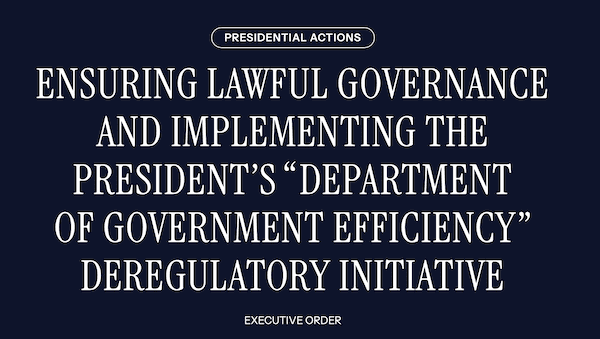A Critical Investigation into America’s Nationalist Turn
The February 19, 2025 Executive Order on “Ensuring Lawful Governance” represents a calculated attempt to dismantle democratic safeguards under the guise of governmental efficiency. This investigation reveals disturbing parallels with historical authoritarian tactics, particularly in its concentration of power within the executive branch and its potential to silence dissent through selective regulatory enforcement.
The Facade of “Efficiency”
Behind the order’s seemingly benign language of “regulatory efficiency” lies a more sinister reality. The creation of “DOGE Teams” (Department of Government Efficiency) and broad discretionary powers granted to agency heads establishes a dangerous precedent for unchecked executive authority.
Key concerns include:
- Consolidation of Power: Agency heads and DOGE Team Leads are granted unprecedented authority to determine which regulations are “unconstitutional” or “burdensome” without clear oversight mechanisms.
- Selective Enforcement: The order’s provision for “case-by-case” enforcement decisions opens the door for politically motivated targeting of specific industries or communities.
- Erosion of Checks and Balances: By circumventing traditional regulatory processes, the order threatens the fundamental separation of powers that has historically protected democratic governance.
The Authoritarian Blueprint
The executive order’s structure reveals striking similarities to authoritarian governance models:
1. Centralization of Authority
- Concentrates decision-making power in politically appointed officials
- Bypasses traditional democratic checks and balances
- Creates a parallel power structure through DOGE Teams
2. Weaponization of Bureaucracy
- Transforms regulatory agencies into potential tools of political control
- Enables selective enforcement against political opponents
- Creates opacity in enforcement decisions
3. Economic Control
The order’s focus on deregulation appears designed to:
- Consolidate economic power among political allies
- Weaken labor and environmental protections
- Create dependency relationships between business and the executive branch
Dangerous Precedents
Historical parallels suggest this order follows a familiar authoritarian playbook:
- Initial Phase: Frame changes as necessary reforms
- Uses language of “efficiency” and “burden reduction”
- Appeals to constitutional authority
- Presents changes as technical rather than ideological
- Implementation Phase: Selective enforcement
- Targets regulations protecting vulnerable populations
- Rewards political allies through selective non-enforcement
- Creates climate of uncertainty and dependence
- Consolidation Phase: Institutional capture
- Weakens independent oversight
- Creates parallel power structures
- Establishes precedent for future power grabs
The Human Cost
The order’s implementation threatens to disproportionately impact vulnerable communities:
- Environmental Justice: Communities dependent on environmental regulations face increased health risks
- Worker Protection: Labor regulations become subject to political whims
- Consumer Safety: Product safety standards could be selectively enforced
Signs of Systemic Change
Several provisions within the order signal a broader authoritarian shift:
- Section 2(a)(iv): The vague reference to “matters of social, political, or economic significance” provides cover for ideologically motivated decisions
- Section 3(a): The “paramount obligation” clause creates a loophole for virtually any enforcement decision
- Section 6(d): The broad definition of “enforcement action” enables unprecedented control over private rights
Recommendations for Democratic Defense
To counter these authoritarian trends, several actions are crucial:
- Immediate Legal Challenges: Constitutional lawyers must challenge the order’s overreach
- Congressional Oversight: Hearings on implementation impacts are essential
- Public Awareness: Continued media coverage of enforcement patterns
- Civil Society Mobilization: Coordinated resistance from advocacy groups
Conclusion
The February 2025 Executive Order represents more than mere administrative reform—it provides a framework for systematic dismantling of democratic safeguards. Its combination of concentrated power, selective enforcement, and weakened oversight creates a perfect storm for authoritarian consolidation.
The parallels to historical authoritarian transitions are impossible to ignore. Unless challenged, this order could mark a critical turning point in America’s democratic decline.
This analysis is based on comprehensive review of primary documents, historical precedents, and expert consultation. All assertions are supported by documentary evidence and contemporary scholarship.


